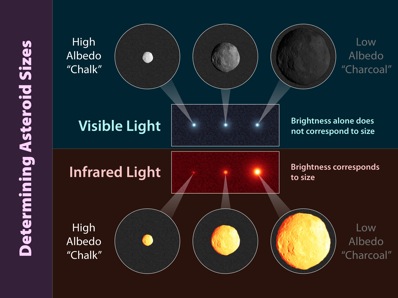


|

|
 |
|
Asteroid census reduces risk to Earth KEITH COOPER for ASTRONOMY NOW Posted: 01 October 2011 The world is a safer place today after it was announced that 93 percent of all near-Earth asteroids larger than a kilometre have been identified, and none of the them pose a risk to Earth. The findings are the result of NEOWISE: a survey with NASA’s orbiting Wide-field Infrared Survey Explorer (WISE) with the aim of drawing conclusions about the asteroid population in Earth’s vicinity. “It’s like a population census, where you poll a small group of people to draw conclusions about the entire country,” says Amy Mainzer who led the NEOWISE study from NASA’s Jet Propulsion Laboratory. “The results substantially reduce the risk of an impact without warning.”  Infrared observations are able to determine the size of an asteroid better than visible light studies, where small, highly reflective asteroids can appear as bright as large, dull asteroids. Image: NASA/JPL–Caltech. In 1998 NASA was issued a command to identify at least 90 percent of the large asteroids that orbited the Sun within 195 million kilometres of Earth’s orbit and which could pose a risk to Earth. The NEOWISE survey brings the total number of known near-Earth asteroids larger than a kilometre wide to 911, with an estimated total population of 981. These are the asteroids that could seriously affect civilisation should they collide with Earth, devastating large areas, creating terrifying tsunami waves and plunging the planet into cold darkness as dust thrown up by a collision clogs the atmosphere. The orbits of these large objects have been plotted, showing that they are no risk to Earth, at least not for the next few centuries. However, while global armageddon seems to have been ruled out, a danger still lurks from the population of mid-sized asteroids, ranging in size from 100 metres to a kilometre. Although NEOWISE’s survey estimates that there are 19,500 of these objects – far fewer than the 35,000 that had previously been estimated – around 14,000 remain unidentified. If one of these were to hit Earth, it could obliterate a large conurbation with a direct strike, or damage coastal areas with a tsunami if it plunged into an ocean. Furthermore, there are estimated to be a million objects smaller than 100 metres unaccounted for, but these were too small for WISE’s infrared detectors to spot.  A chart depicting the asteroid population that a) we have so far discovered, b) the new estimated totals based on NEOWISE results, and c) the old estimated totals that now seem too high. Image: NASA/JPLÐCaltech. Nevertheless, observing in infrared light gave NEOWISE an advantage over ground-based, visible light surveys, says Tim Spahr, Director of the Minor Planet Center. “In visible light, a small bright object will look like a large dark object [from Earth],” he says. “But in infrared the larger asteroids are the brightest, so we see their true sizes.” The extinction of the dinosaurs from a likely asteroid strike (but WISE has recently asked the question, which asteroid was it? see here for our recent news story), as well as dramatised depictions of asteroid impacts in movies like Deep Impact and Armageddon, has propelled the fear of such an event into the public consciousness. Although surveys of the near-Earth asteroid population will remain vigilant in the future, the good news from WISE is that perhaps many of our fears have been unduly warranted. |
|
|
|
|